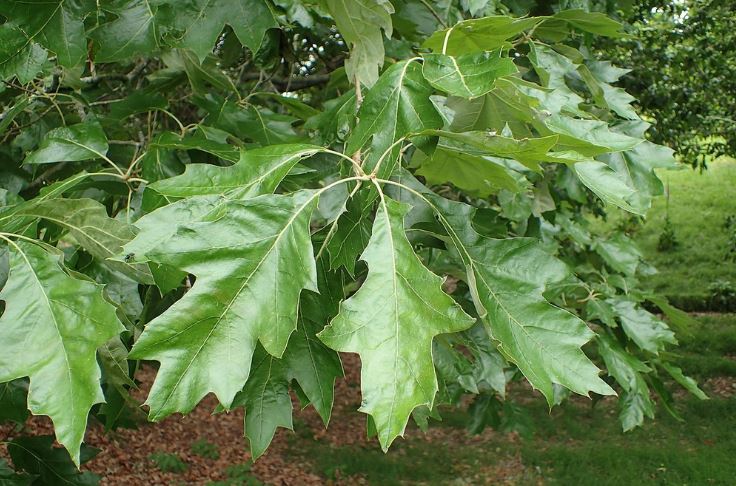
Quercus pagoda, commonly known as the Cherrybark Oak, is a member of the Quercus genus within the Fagaceae family. This species is part of the red oak group, characterized by leaves with pointed, bristle-tipped lobes and acorns that take two years to mature. The name “pagoda” refers to the pagoda-like shape of its leaves when viewed from above.
The Cherrybark Oak is native to the southeastern United States. Its range includes areas from southeastern Virginia southward through the Carolinas, Georgia, and Florida, then westward through Alabama, Mississippi, Louisiana, into eastern Texas, and northward into parts of Tennessee, Arkansas, Missouri, and southern Illinois. It typically inhabits moist, well-drained bottomland forests, often along rivers or in floodplain areas.
Historically, Quercus pagoda has been valued for its timber, which is among the strongest and most durable of the red oaks, making it ideal for furniture, flooring, and construction. Its wood was particularly sought after for its straight grain and resistance to decay. Indigenous peoples may have used its acorns for food, and its bark for medicinal purposes. The name “Cherrybark” derives from its bark’s resemblance to that of cherry trees. Over time, Cherrybark Oak has been appreciated for both its ecological value, providing habitat and food for wildlife, and its aesthetic appeal in landscapes, especially noted for its fast growth and high-quality lumber.
Cherrybark Oak is well-adapted to USDA Hardiness Zones 6 through 9. This range reflects its preference for the warm, humid climates of the southeastern U.S., where it can benefit from both the heat of summer and the moisture often present in its native bottomland habitats. Within these zones, it’s valued for its rapid growth, ecological contributions, and the quality of its wood, making it a significant tree for both natural ecosystems and managed landscapes, particularly where soil moisture is consistent but well-drained.
The range of Quercus pagoda, known as the Cherrybark Oak, spans across the southeastern United States, starting from southeastern Virginia and extending south through North Carolina, South Carolina, Georgia, and Florida. It continues westward through Alabama, Mississippi, Louisiana, into eastern Texas, and then northward into parts of Tennessee, Arkansas, Missouri, and southern Illinois. This species is commonly found in moist, well-drained bottomland forests, along rivers, or in floodplain environments where it can thrive with consistent moisture.
Characteristics
- Growth Habit: Cherrybark Oak is a large, deciduous hardwood tree with a tall, straight trunk and a symmetrical, spreading crown. It is highly valued for its strong timber and attractive form.
- Size: Mature trees can reach heights of 100 to 130 feet, with trunk diameters up to 4 feet. They are among the tallest of the red oak species.
- Growth Rate: The tree has a fast growth rate under favorable conditions, often adding 2 to 3 feet in height annually during its early years.
- Leaves: The glossy green leaves are shaped like an inverted triangle or pagoda, with 5 to 9 deep lobes. In autumn, they turn vibrant shades of red and brown before shedding.
- Acorns: The tree produces rounded acorns, about 0.5 to 1 inch long, encased in shallow, scaly caps. Acorns mature in two seasons and are a crucial food source for wildlife.
- Lifespan: Cherrybark Oaks can live for 100 to 150 years or more, depending on environmental conditions and proper care.
- Bark: The bark is rough and deeply furrowed, with a grayish-brown hue that develops a cherry-like appearance as the tree matures.
- Roots: The root system is deep and widespread, providing excellent stability and drought tolerance. This extensive root network also helps the tree thrive in flood-prone bottomlands.
Cultivation
- Preferred Soil: Thrives in deep, fertile, and well-drained loamy soils but tolerates periodic flooding in bottomland areas.
- Light Requirements: Grows best in full sun, requiring at least 6 to 8 hours of direct sunlight daily for optimal growth.
- Water Needs: Prefers moist soil conditions but can tolerate short periods of drought once established. Regular watering is essential during the early growth stages.
- Planting Time: The best time for planting is in early spring or fall when the soil is warm, and conditions are stable.
- Spacing: Plant trees 40 to 60 feet apart to allow room for their large canopy and deep root systems to spread.
- Mulching: Apply a 2 to 3-inch layer of mulch around the base to retain moisture, regulate soil temperature, and reduce weed competition.
- Pruning: Prune during late winter to remove dead or diseased branches and maintain a strong central leader for better structure.
- Fertilization: Apply a balanced, slow-release fertilizer in early spring to promote healthy growth, especially in poor soils.
- Pest and Disease Management: Generally resistant to pests but may be affected by oak wilt or leaf spots. Monitor regularly and take preventive measures.
- Wildlife Attraction: Plant in areas where wildlife management is valued, as acorns are a vital food source for deer, squirrels, and birds.